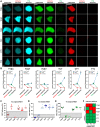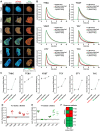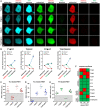A Combined Acceptor Photobleaching and Donor Fluorescence Lifetime Imaging Microscopy Approach to Analyze Multi-Protein Interactions in Living Cells
- PMID: 34055873
- PMCID: PMC8160235
- DOI: 10.3389/fmolb.2021.635548
A Combined Acceptor Photobleaching and Donor Fluorescence Lifetime Imaging Microscopy Approach to Analyze Multi-Protein Interactions in Living Cells
Abstract
Protein-protein interaction studies often provide new insights, i.e., into the formation of protein complexes relevant for structural oligomerization, regulation of enzymatic activity or information transfer within signal transduction pathways. Mostly, biochemical approaches have been used to study such interactions, but their results are limited to observations from lysed cells. A powerful tool for the non-invasive investigation of protein-protein interactions in the context of living cells is the microscopic analysis of Förster Resonance Energy Transfer (FRET) among fluorescent proteins. Normally, FRET is used to monitor the interaction state of two proteins, but in addition, FRET studies have been used to investigate three or more interacting proteins at the same time. Here we describe a fluorescence microscopy-based method which applies a novel 2-step acceptor photobleaching protocol to discriminate between non-interacting, dimeric interacting and trimeric interacting states within a three-fluorophore setup. For this purpose, intensity- and fluorescence lifetime-related FRET effects were analyzed on representative fluorescent dimeric and trimeric FRET-constructs expressed in the cytosol of HEK293 cells. In particular, by combining FLIM- and intensity-based FRET data acquisition and interpretation, our method allows to distinguish trimeric from different types of dimeric (single-, double- or triple-dimeric) protein-protein interactions of three potential interaction partners in the physiological setting of living cells.
Keywords: 3-way FRET; FLIM; acceptor photobleaching; multiple protein–protein interactions; three-fluorophore FRET.
Copyright © 2021 Eckenstaler and Benndorf.
Conflict of interest statement
The authors declare that the research was conducted in the absence of any commercial or financial relationships that could be construed as a potential conflict of interest.
Figures






Similar articles
-
Protein localization in living cells and tissues using FRET and FLIM.Differentiation. 2003 Dec;71(9-10):528-41. doi: 10.1111/j.1432-0436.2003.07109007.x. Differentiation. 2003. PMID: 14686950 Review.
-
Investigating protein-protein interactions in the plant endomembrane system using multiphoton-induced FRET-FLIM.Methods Mol Biol. 2014;1209:81-95. doi: 10.1007/978-1-4939-1420-3_6. Methods Mol Biol. 2014. PMID: 25117276
-
Photobleaching-based quantitative analysis of fluorescence resonance energy transfer inside single living cell.J Fluoresc. 2010 Jan;20(1):27-35. doi: 10.1007/s10895-009-0518-3. Epub 2009 Jul 9. J Fluoresc. 2010. PMID: 19588234
-
Sensitivity of CFP/YFP and GFP/mCherry pairs to donor photobleaching on FRET determination by fluorescence lifetime imaging microscopy in living cells.Microsc Res Tech. 2006 Nov;69(11):933-9. doi: 10.1002/jemt.20370. Microsc Res Tech. 2006. PMID: 16941642
-
Optical methods in the study of protein-protein interactions.Adv Exp Med Biol. 2010;674:33-42. doi: 10.1007/978-1-4419-6066-5_4. Adv Exp Med Biol. 2010. PMID: 20549938 Review.
Cited by
-
A renal YY1-KIM1-DR5 axis regulates the progression of acute kidney injury.Nat Commun. 2023 Jul 17;14(1):4261. doi: 10.1038/s41467-023-40036-z. Nat Commun. 2023. PMID: 37460623 Free PMC article.
-
De Novo Designed Cell-Penetrating Peptide Self-Assembly Featuring Distinctive Tertiary Structure.ACS Omega. 2024 Jul 16;9(30):32991-32999. doi: 10.1021/acsomega.4c04004. eCollection 2024 Jul 30. ACS Omega. 2024. PMID: 39100342 Free PMC article.
-
Strongly coupled plasmon-exciton polaritons for photobleaching suppression.Nanophotonics. 2024 Aug 28;13(22):4091-4099. doi: 10.1515/nanoph-2024-0259. eCollection 2024 Sep. Nanophotonics. 2024. PMID: 39635442 Free PMC article.
-
Direct GPCR-EGFR interaction enables synergistic membrane-to-nucleus information transfer.Cell Mol Life Sci. 2024 Jun 20;81(1):272. doi: 10.1007/s00018-024-05281-5. Cell Mol Life Sci. 2024. PMID: 38900158 Free PMC article.
-
Multiplexed imaging for probing RAS-RAF interactions in living cells.Biochim Biophys Acta Biomembr. 2023 Aug;1865(6):184173. doi: 10.1016/j.bbamem.2023.184173. Epub 2023 May 19. Biochim Biophys Acta Biomembr. 2023. PMID: 37211322 Free PMC article.
References
LinkOut - more resources
Full Text Sources
Other Literature Sources
Research Materials

